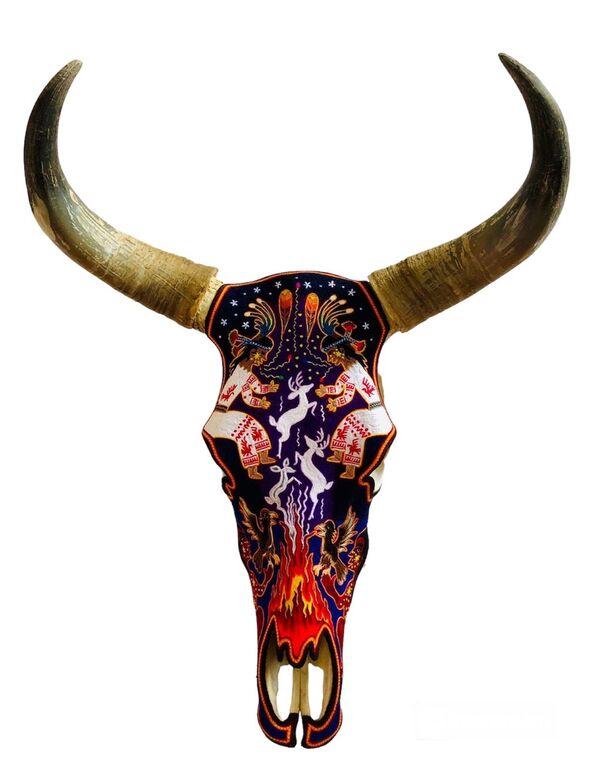 Español
Español
June 23, 2024
"My pictures are read, as men grow, from the bottom up." - Tower Saints, Huichol artist
by Patricia Argüello Melgar
Huichol art achieves a perfect balance between color and form. According to their worldview it is through color that the gods speak to men. And the forms are sacred symbols that they have found in their spiritual communication: the sun, the deer, the star, the peyote, the corn; among the most precious.
The Huichol people call themselves Wixárika or Wixaritari. They inhabit areas of western Mexico, Jalisco and Nayarit mainly. There are also some minority groups in Zacatecas and Durango.
They express their art with two materials: yarn and chaquira. The yarns are threads of natural or synthetic fibers: cotton, wool, silk and acrylic. The chaquira are small beads usually of glass or plastic, although they are also made of clay, shells, corals and seeds. in their dialect "tukari" means life so the use in their art is an allegory to life. The art works are made on boards and the hands, as if tilling the earth, place the beeswax (natural glue) and combine colors until they discover and capture the sacred forms that inspire them.
Huichol art is an ancestral tradition, an important cultural heritage of Mexico. Their art is the expression and physical manifestation of the images visualized by the Huichol shamans in their ceremonies and rites celebrated in their communities. With chants, prayers and the ingestion of peyote (hikuri) they relate to the divine.
They make long pilgrimages walking alone or in groups from their native villages to the Cerro del Quemado that is located in Real de Catorce. At the top of this mountain is their Temple to the Sun. There they offer pieces of their art and light candles to thank life through prayer and ask for the well-being of their crops and communities.
"Holy Ceremony"

Cow or deer skulls with horns are very special in Huichol art. This skull represents a sacred ceremony by the Huichol artist Gonzalo Hernández. Like much Huichol art, its reading is from the bottom up. We start from the sacred fire guarded by two eagles where two shamans perform a sacred ceremony. Their prayers transmute fire into their sacred symbol, the deer; making love and goodness present in the world. Here we can also appreciate the beautiful color and embroidery of the costumes worn by men of knowledge and also, the beautiful plumes that they themselves make with feathers that they collect throughout their lives.
*
Huichols consider that life was born in the sea. Therefore, in the first part of their pilgrimage they go to the sea and festively enter its waters, singing: "We come to the sea and we go to the desert." The pilgrimage then culminates in the desert of Wirikuta in the Cerro del Quemado in Real de Catorce. The pilgrimage to Wirikuta is along a ceremonial route stretching over 550 kilometres. For many days they sing, tell stories and perform rituals where they share their knowledge. Their pilgrimages are the way to keep their knowledge alive. Since the Huichol language has no script, the pilgrimage is their main source of learning and transmission of intergenerational knowledge.
The term Wixarika means "deep-hearted person who loves knowledge." Huichol art is based on the understanding of the Nierika; which is the ability to see the true form of the world revealed by the Gods and ancestors through certain ritual practices.
Huichol art is expressed in paintings made with yarn and wooden figures covered with chaquira. Here I show some pieces where you can appreciate the integration of their most important symbols within their sacred cosmovision.
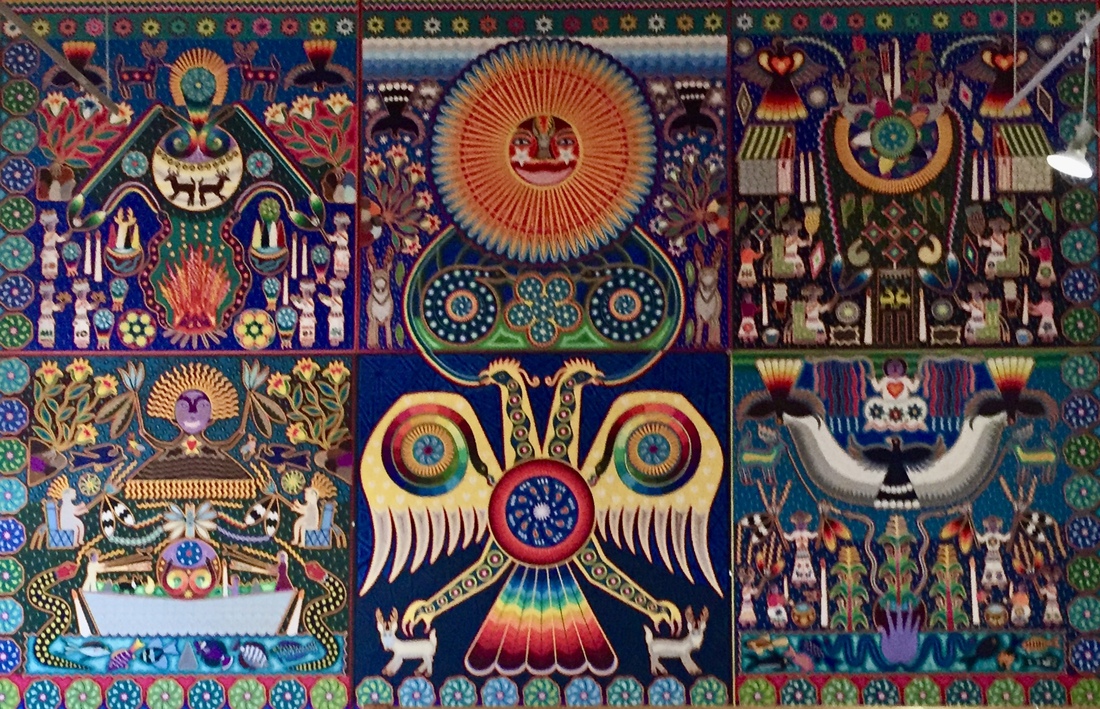
Birth of the Sun, Benito de la Cruz Carrillo
thread, yarn, Campeche wax on board
*

With yarn or chaquira the Huichol or Wixarica artists recreate the visions they receive in their sacred ceremonies that they perform in their festivities within their communities, pilgrimages or in their daily prayers. They burn copal and offer flowers of many colors on their altars where they find various religious images. They pray and ask for inspiration for their new art or piece that they will elaborate.
"Qixote Huichol"
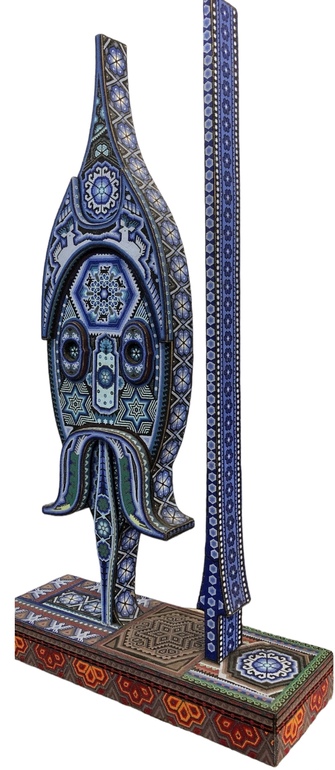
Huichol art in wooden figures covered with chaquiras is also very beautiful. The Mexican artist Jesús Guzmán expresses his art through an allegory to Don Quijote de la Mancha; "changing the world, friend Sancho, is not madness or utopia... ¡ but justice!" This piece by Quixo was elaborated by Lucas Castro Jiménez, who is a well-known exponent of Huichol, Wixarika art.
*
The Huichol world is divided into three dimensions: that of mythology, which believes that life began in the ocean; that of corn, which sustains daily life and its traditions; and that of mysticism, which establishes that the world has a sacred dimension and its art expresses its veneration of its Gods and sacred symbols.
Within the Huichol cosmovision pilgrimages are a rite repeated year after year. They are a legacy that is transmitted intergenerationally. Their ancestors traveled the road and their children take up the lead.
At the end of their pilgrimage the Huichols collect peyote in the Wirikuta desert to bring home, to their places of origin, to their temples. Peyote in their language is known as "hikuri". They ingest it in their special celebrations to receive the "nierika" or "gift of seeing." And so, generation after generation go through the same paths, honoring their sacred symbols like the sun, the blue deer, the corn. In their rites their voices converge in a single chant; their prayers inspire them to find the strength and collective tenacity to fulfill their ancestral traditions.
***
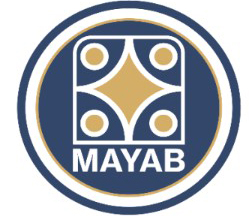
The pieces "Ceremonia Sagrada" and "Quixote Huichol" are on display and sale in Mayab
Furniture Art Design
Mayab is a space of art and design of furniture in precious woods. Our pieces are crafted with precision and care to create a beautiful and functional work of art. Mayab offers a selection of paintings and sculptures by renowned Mexican and foreign artists. It also promotes the talent of the artisans of San Miguel de Allende and other Mexican cultures such as the Mayan, Huichol, Otomi, Tarascan, etc.
Mayab means "holy land of the Mayas where artists can enter and express themselves."
Lavinia's Art Space, Calzada de la Estación 151
Instagram
**************
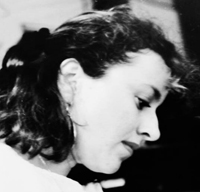
Patricia Argüello Melgar is from Chiapas. She grew up playing among the coffee bushes and running barefoot over the coffee cherries that sunned on the patios of the houses in her town. She enjoys the art of learning and teaching, which is why she dedicated many years to academia in the fields of economics, public administration and education. She is an admirer of the Mayan culture, which is why she has taken up the concept of the seed and star to enter the market through Mayab.
mayab.sma@gmail.com
**************
*****
Please contribute to Lokkal,
SMA's online collective:
 ***
***
Discover Lokkal:
Watch the two-minute video below.
Then, just below that, scroll down SMA's Community Wall.
Mission

Visit SMA's Social Network
Contact / Contactar

